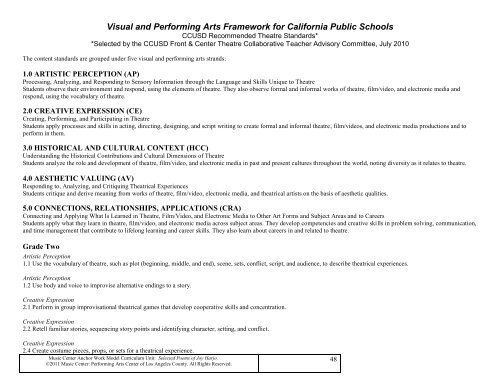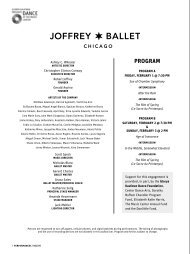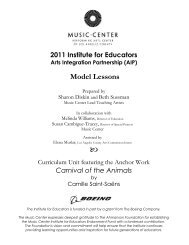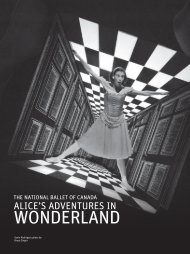Selected Poems of Joy Harjo - Music Center
Selected Poems of Joy Harjo - Music Center
Selected Poems of Joy Harjo - Music Center
Create successful ePaper yourself
Turn your PDF publications into a flip-book with our unique Google optimized e-Paper software.
Visual and Performing Arts Framework for California Public Schools<br />
CCUSD Recommended Theatre Standards*<br />
*<strong>Selected</strong> by the CCUSD Front & <strong>Center</strong> Theatre Collaborative Teacher Advisory Committee, July 2010<br />
The content standards are grouped under five visual and performing arts strands:<br />
1.0 ARTISTIC PERCEPTION (AP)<br />
Processing, Analyzing, and Responding to Sensory Information through the Language and Skills Unique to Theatre<br />
Students observe their environment and respond, using the elements <strong>of</strong> theatre. They also observe formal and informal works <strong>of</strong> theatre, film/video, and electronic media and<br />
respond, using the vocabulary <strong>of</strong> theatre.<br />
2.0 CREATIVE EXPRESSION (CE)<br />
Creating, Performing, and Participating in Theatre<br />
Students apply processes and skills in acting, directing, designing, and script writing to create formal and informal theatre, film/videos, and electronic media productions and to<br />
perform in them.<br />
3.0 HISTORICAL AND CULTURAL CONTEXT (HCC)<br />
Understanding the Historical Contributions and Cultural Dimensions <strong>of</strong> Theatre<br />
Students analyze the role and development <strong>of</strong> theatre, film/video, and electronic media in past and present cultures throughout the world, noting diversity as it relates to theatre.<br />
4.0 AESTHETIC VALUING (AV)<br />
Responding to, Analyzing, and Critiquing Theatrical Experiences<br />
Students critique and derive meaning from works <strong>of</strong> theatre, film/video, electronic media, and theatrical artists on the basis <strong>of</strong> aesthetic qualities.<br />
5.0 CONNECTIONS, RELATIONSHIPS, APPLICATIONS (CRA)<br />
Connecting and Applying What Is Learned in Theatre, Film/Video, and Electronic Media to Other Art Forms and Subject Areas and to Careers<br />
Students apply what they learn in theatre, film/video, and electronic media across subject areas. They develop competencies and creative skills in problem solving, communication,<br />
and time management that contribute to lifelong learning and career skills. They also learn about careers in and related to theatre.<br />
Grade Two<br />
Artistic Perception<br />
1.1 Use the vocabulary <strong>of</strong> theatre, such as plot (beginning, middle, and end), scene, sets, conflict, script, and audience, to describe theatrical experiences.<br />
Artistic Perception<br />
1.2 Use body and voice to improvise alternative endings to a story.<br />
Creative Expression<br />
2.1 Perform in group improvisational theatrical games that develop cooperative skills and concentration.<br />
Creative Expression<br />
2.2 Retell familiar stories, sequencing story points and identifying character, setting, and conflict.<br />
Creative Expression<br />
2.4 Create costume pieces, props, or sets for a theatrical experience.<br />
<strong>Music</strong> <strong>Center</strong> Anchor Work Model Curriculum Unit: <strong>Selected</strong> <strong>Poems</strong> <strong>of</strong> <strong>Joy</strong> <strong>Harjo</strong>.<br />
©2011 <strong>Music</strong> <strong>Center</strong>: Performing Arts <strong>Center</strong> <strong>of</strong> Los Angeles County. All Rights Reserved.<br />
48






